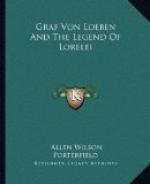In the first place, Heine never knew Brentano personally, and never mentions him in his letters previous to 1824, nor in his letters[35] that have thus far been published after 1824. Godwi was repudiated soon after its publicatipn by Brentano himself, who said[36] there was only one good thing about it, the title, for, after people had said “Godwi,” they could just keep on talking and say, “Godwi, dumm.” On its account, Caroline called him Demens Brentano, while Dorothea dubbed him “Angebrenntano.” The novel became a rare and unread book until Anselm Ruest brought out a new edition[37] with a critical and appreciative introduction in 1906. Diel and Kreiten say “es ging fast spurlos vorUeber.” It was not included in his Gesammelte Schriften (1852-55), though the ballad[38] was. Heine does not mention it in his Romantische Schule, which was, however, written ten years after he had finished his “Die Lorelei.” And as to the contents of Brentano’s ballad, there is precious little in it that resembles Heine’s ballad, aside from the name of the heroine, and even here the similarity is far from striking.
And yet, despite all this, commentators continue to say that Heine drew the initial inspiration for his “Lorelei” from Brentano. They may be right, but no one of them has thus far produced any tenable argument, to say nothing of positive proof. The most recent supporter of Brentano’s claim is Eduard Thorn[39] (1913), who reasons as follows:
Heine knew Brentano’s works in 1824, for in that year he borrowed Wunderhorn and TrOesteinsamkeit from the library at GOettingen. These have, however, nothing to do with Brentano’s ballad, and it is one year too late for Heine’s ballad. All of Thorn’s references to Heine’s Romantische Schule, wherein Godwi, incidentally, is not mentioned, though other works are, collapse, for this was written ten years too late. And then, to quote Thorn: “Loeben’s Gedicht lieferte das direkte Vorbild fUer Heine.” He offers no proof except the statements of Strodtmann, Hessel, and Elster to this effect.
And again: “Der Name Lorelay findet sich bei Loeben nicht als Eigenname, wenn er auch das Gedicht, ‘Der Lurleifels’ Ueberschreibt.” But the name Loreley does occur[40] twice on the same page on which the last strophe of the ballad is published in Urania, and here the ballad is not entitled “Der Lurleifels,” but simply “Loreley.” Now, even granting that Loeben entitled his ballad one way in the MS and Brockhaus published it in another way in Urania, it is wholly improbable that Heine saw Loeben’s MS previous to 1823.




